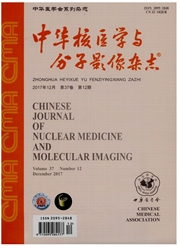

 中文摘要:
中文摘要:
目的制备新型的光动力治疗(PDT)光敏剂及荧光纳米探针,并评估其在胰腺癌诊疗中的应用价值。方法利用MSNs包载ICG制成纳米探针ICG/MSNs,采用MTT法评估其毒性。ICG/MSNs与人胰腺癌细胞共同温育24h后,利用近红外体视荧光显微镜观察摄取情况。分别用PBS、ICG(10μg/ml)、MSNs和ICG/MSNs(含ICG10μg/ml)与人胰腺癌细胞共同温育24h,经(780±25)nm激光、以500mW/cm。的照射强度PDT后,用MTF法检测细胞存活率,评估治疗效果。建立荷人胰腺癌裸鼠皮下肿瘤模型,用小动物活体荧光成像仪(IVIS)观察ICG/MSNs在体分布情况。参照ICG按体质量0.5mg/kg的注射量,给PBS对照组、ICG组和ICG/MSNs组(4只/组)荷瘤裸鼠经尾静脉分别注射150μlPBS、ICG溶液和ICG/MSNs溶液,经同样的PDT疗程后,用IVIS的BLI功能观察肿瘤生长情况2周,评估在体PDT效果。用近红外体视荧光显微镜观察ICG/MSNs在人胰腺癌肿瘤上的荧光成像效果。采用单因素方差分析处理数据。结果ICG/MSNs直径约100nm,可被胰腺癌细胞摄取;胰腺癌细胞与ICG/MSNs、ICG、MSNs或PBS共同温育后,经PDT处理,存活率分别为(24.5±5.0)%、(81.2±1.6)%、(90.7±2.0)%和(93.4±1.7)%(F=212.289,P〈0.05);其中ICG/MSNs组比ICG组治疗效果明显(P〈0.05);荷瘤裸鼠经PDT12d后,肉眼观察ICG/MSNs组肿瘤无复发生长,ICG组和PBS对照组肿瘤生长明显。PBS对照组、ICG组和ICG/MSNs组肿瘤区域BL1分别为(61.2±7.7)×10^8、(56.7±9.0)×10^8和(2.4±1.5)×10^8(F=67.098,P〈0.05),其中ICG/MSNs组与ICG组差异有统计学意义(P〈0.05)。在近红外体视荧光显微镜下通过ICG/MSNs的荧光效果能清晰观察肿瘤位置。结论ICG/MSNs生物适应性良好,对胰腺癌细胞及在体胰腺癌肿瘤具有良好的成像及PDT效果。
 英文摘要:
英文摘要:
Objective To develop MSNs loaded with ICG and investigate its diagnostic value and photodynamic therapeutic value in the experimental pancreatic cancer. Methods ICG was loaded into MSNs to prepare the ICG/MSNs probe. The probe toxicity was evaluated by MTT assays. Near-infrared stereo fluorescence microscope (NISFM) was applied to investigate whether the ICG/MSNs would be uptaken by the human pancreatic cancer cells. After incubated with PBS, ICG ( 10 μg/ml), MSNs or ICG/MSNs ( 10 μg/ml ICG) for 24 h and treated with photodynamic therapy (PDT, (780±25) nm laser, 500 mW/cm2), the human pancreatic cancer cells survival rate was determined by MTT method. The human pancreatic cancer cells were implanted into nude mice to prepare subcutaneous tumor models. The distribution of ICG/MSNs in subcutaneous tumor models was studied with in vivo imaging system (IVIS). With reference to the injection dose of ICG(0.5 mg/kg), the mice in PBS group, ICG group, ICG/MSNs group (4 mice per group) were injected via tail vein with 150 μl PBS, ICG solution and ICG/MSNs solution, resp.ectively. After treated by PDT for 48 h, the mice were observed by IVIS for 2 weeks using BLI to evaluate the therapeutic effect of PDT. NISFM was used to observe the fluorescence in tumor region. One-way analysis of variance was used to analyze the data. Results The diameter of ICG/MSNs was about 100 nm and it could be uptaken by human pancreatic cancer cells. After treated by PDT, the survival rates of human pancreatic cancer ceils were (24. 5±5.0)%, (81.2±1.6)%, (90.7±2.0)% and (93.4±1.7)% in ICG/MSNs group, ICG group, MSNs group and PBS group, respectively ( F = 212. 289, P〈 0.05 ). ICG/MSNs group showed better therapeutic effect than ICG group(P〈0.05). After 12 d treated by PDT, the tumor did not recur or grow in ICG/MSNs group, but grew obviously in ICG group and PBS group. The BLI of tumor area in PBS group, ICG group and ICG/MSNs group were (61.2±7.7) ×10^8, (56.7±9.0) ?
 同期刊论文项目
同期刊论文项目
 同项目期刊论文
同项目期刊论文
 期刊信息
期刊信息
